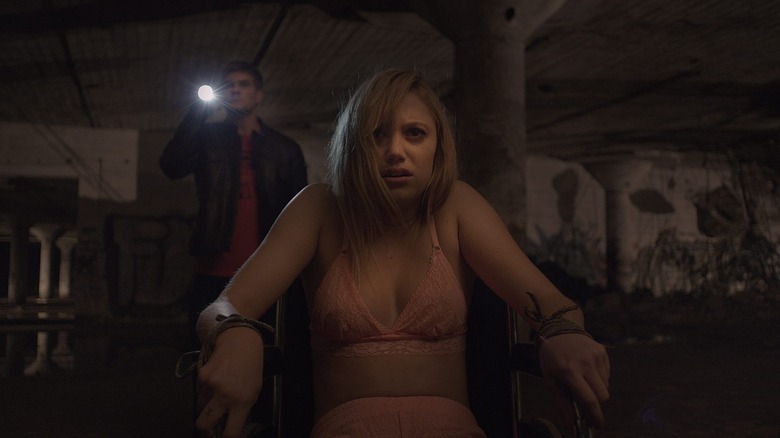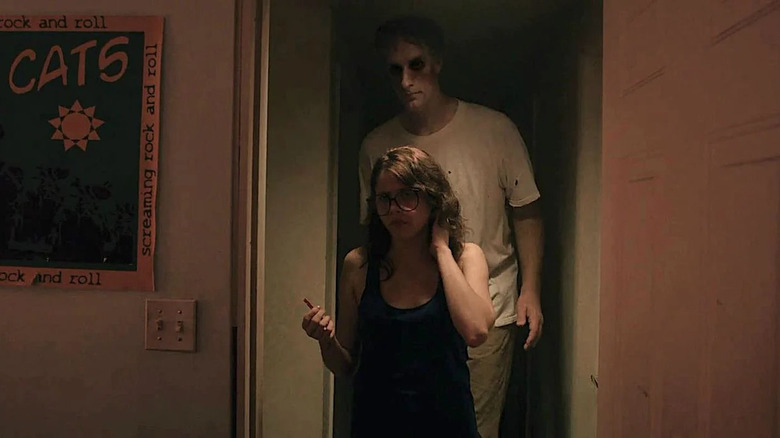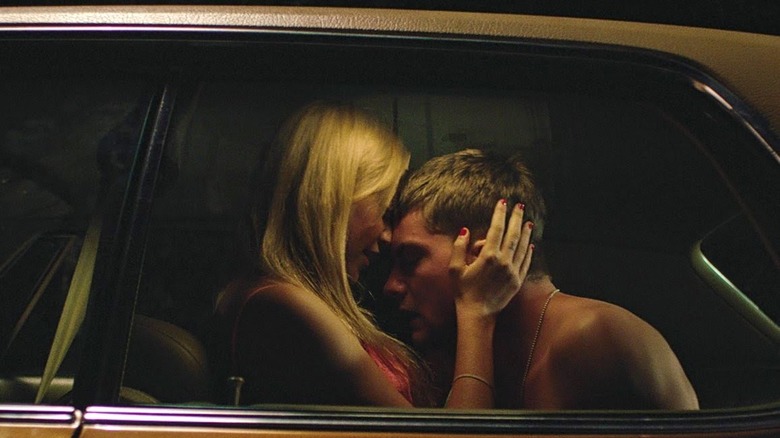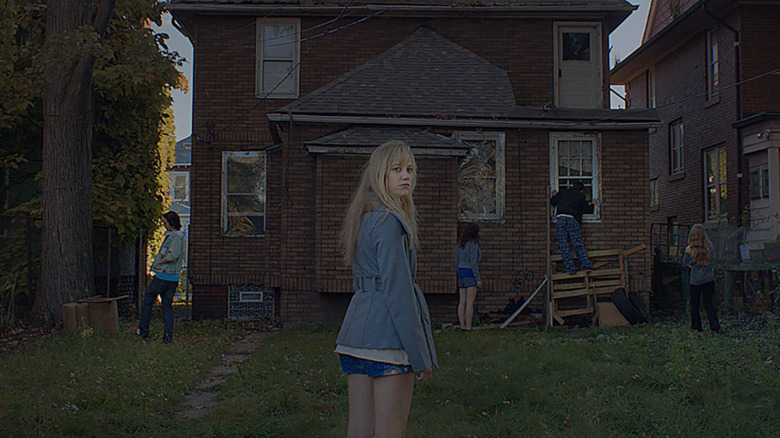
"It Follows," the 2014 psychological horror film by director and screenwriter David Robert Mitchell, has been interpreted by viewers as being inspired by the risks and anxiety associated with sex and sexually transmitted diseases. On the surface, this interpretation is perfectly justifiable: the movie centers around the some of the deeply uncomfortable aspects of teenage sexuality, taking the classic "death by sex" horror trope to a terrifying literal extreme. However, Mitchell himself has revealed that his primary source of inspiration behind "It Follows" didn't actually involve sex at all. So what was it that inspired him to create what some have dubbed "the STD horror movie"?
Childhood Nightmares

The answer is actually heavily alluded to in the first half of the film, during the scene in which the character Hugh is describing the titular "It" to Jay, "It could look like someone you know, or it could be a stranger in a crowd. Whatever helps it get close to you. It could look like anyone, but there's only one of it. And sometimes ... Sometimes I think it looks like people you love, just to hurt you."
As it turns out, these lines are extremely similar to the director's own words regarding his initial source of inspiration for "It Follows." As he told IndieWire:
"The basic idea came from a recurring nightmare that I had when I was a kid in which I was followed by a monster that looked like different people. And only I could see it. And it was very slow and it was always walking toward me. In the dream I could get away from it easily or sort of easily. I could come into a room, climb out of a window, run down an alley, or go into the street. It wasn't about it being able to overtake me, it was the feeling of dread and anxiety knowing that something is always coming for you."
Other hints at a childhood nightmare serving as the foundation for the idea behind "It Follows" are sprinkled throughout the film. In another scene, the aforementioned Hugh states that he wishes he could trade places with a little boy he sees at a movie theatre when prompted with a question by his date. When she asks why a 21-year-old man would want to swap lives with a child, he replies, "How cool would that be to have your whole ahead of you? Look at how happy that kid is."
In addition to Hugh's confession, the teenage characters spend a lot of reminiscing on pre-adolescence and childhood after having been thrust into an unfamiliar, dangerous situation brought on by, among other things, sex. They are literally and figuratively realizing they're past a point of no return. There is no going back to the innocence and shelter of childhood, just as they can't just undo the events that have opened them up to supernatural torment. At one point, another character mentions how her parents wouldn't allow her to "go south of 8 mile" because "that's where the city started and the suburbs ended." She states that she didn't realize the reason why her parents tried to protect her with this rule until she was older.
The Shape Of Anxiety

Further illustrating the source of inspiration for "It Follows" are the themes of anxiety, trust, and inevitable fate. The scariest thing about the monster in "It Follows" isn't the fact that it can kill you. A lot of things we encounter on a daily basis can kill us. The true horror lies in the psychological torment of being steadily pursued by a seemingly unstoppable, omnipresent figure that only you (and those who have crossed the sexual threshold that ensnares them in its supernatural web) can see. The creature doesn't even make an effort to run, implying that it is not concerned with whether or not it can catch you because it knows that, sooner or later, it will. Worse yet, it is shown to take the form of people the characters know, causing them to become mistrustful, anxious, and paranoid. For the protagonist, Jay, it takes the form of her friends, her potential love interests, and — in one particularly horrifying scene — her dead father.
The dread and anxiety born of not knowing if the people you are supposed to love and trust are actually malevolent figures who seek to destroy you is enough to drive anyone insane, but letting your guard down can literally get you killed. Such is the case with one of the other characters, Greg. Greg has sex with Jay despite the fact that the creature is "passed' from one person to the next via sexual intercourse, partially because he's a horny teenager, and partially because doesn't believe that the entity tormenting her exists. His unwillingness to believe or trust her despite the very clear and traumatic toll it has taken on her leads to his demise when the creature tricks him into opening his door by taking the form of his mother. Those impacted by the creature are not safe, and they can never go back to the way things were before, no matter how much or how little they choose to acknowledge the terrifying reality of it all. Their only choices are to live with the anxiety of it all, doing their best to prolong the inevitable, or to die.
Aesthetic Inspiration

"It Follows" is as deeply unsettling as it is picturesque, and intentionally so. The film's surrealistic portrayal of suburbia was inspired by the work of award-winning photographer Gregory Crewdson, who is known for his tableaux vivants (French for "living pictures"). Like Crewdson's work, "It Follows" features intricately staged, dreamlike scenery of American homes and neighborhoods, which is yet another callback to "It Follows" being inspired by screenwriter David Robert Mitchell's childhood nightmare. In the same way that abrupt, nonsensical changes in atmosphere tend to occur in dreams, the seasons appear to change throughout the movie, even though it only takes place over a few days: characters are shown swimming and wearing shorts in the midst of those around them wearing coats and other attire associated with winter. Additionally, the film is rife with imagery that evokes very specific time periods, making the precise decade in which "It Follows" takes place unclear: there are multiple classic cars featured alongside more modern vehicles, the characters dress in modern clothing while the décor in their homes appears to be a mixture of elements from bygone eras like the '50s and the '70s, and one of the characters has an e-reader shaped like a clamshell.
On the curiously anachronistic quality of the film, David Robert Mitchell told the AV Club:
"There are production design elements from the '50s on up to modern day. A lot of it is from the '70s and '80s. That e-reader cell phone—or "shell phone"—you're talking about is not a real device. It's a '60s shell compact that we turned into a cell phone e-reader. So I wanted modern things, but if you show a specific smartphone now, it dates it. It's too real for the movie. It would bother me anyway. So we made one up. And all of that is really just to create the effect of a dream—to place it outside of time, and to make people wonder about where they are. Those are things that I think happen to us when we have a dream."
Given all of this information, it seems a bit dismissive to just label "It Follows" as "the STD horror movie." At its core, it appears to be less about the dangers of sex, and more about the jarring transition from the safety and innocence of childhood to the confusion and anxiety of adolescence, sexual awakening, and the inescapable awareness of danger that comes with it all.
Read this next: Every Terry Gilliam Movie Ranked Worst To Best
The post The Real Inspiration Behind It Follows Probably Isn't What You Think appeared first on /Film.
from /Film https://ift.tt/31adZgk
via IFTTT
Comments
Post a Comment